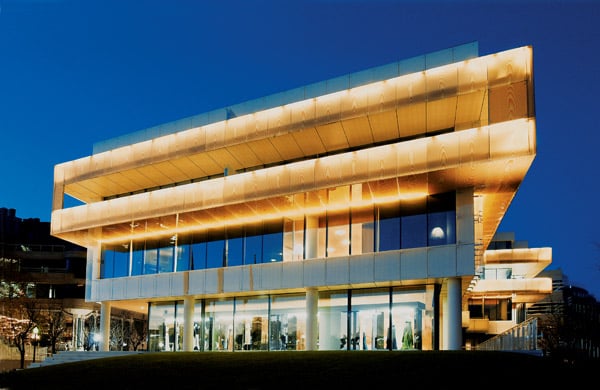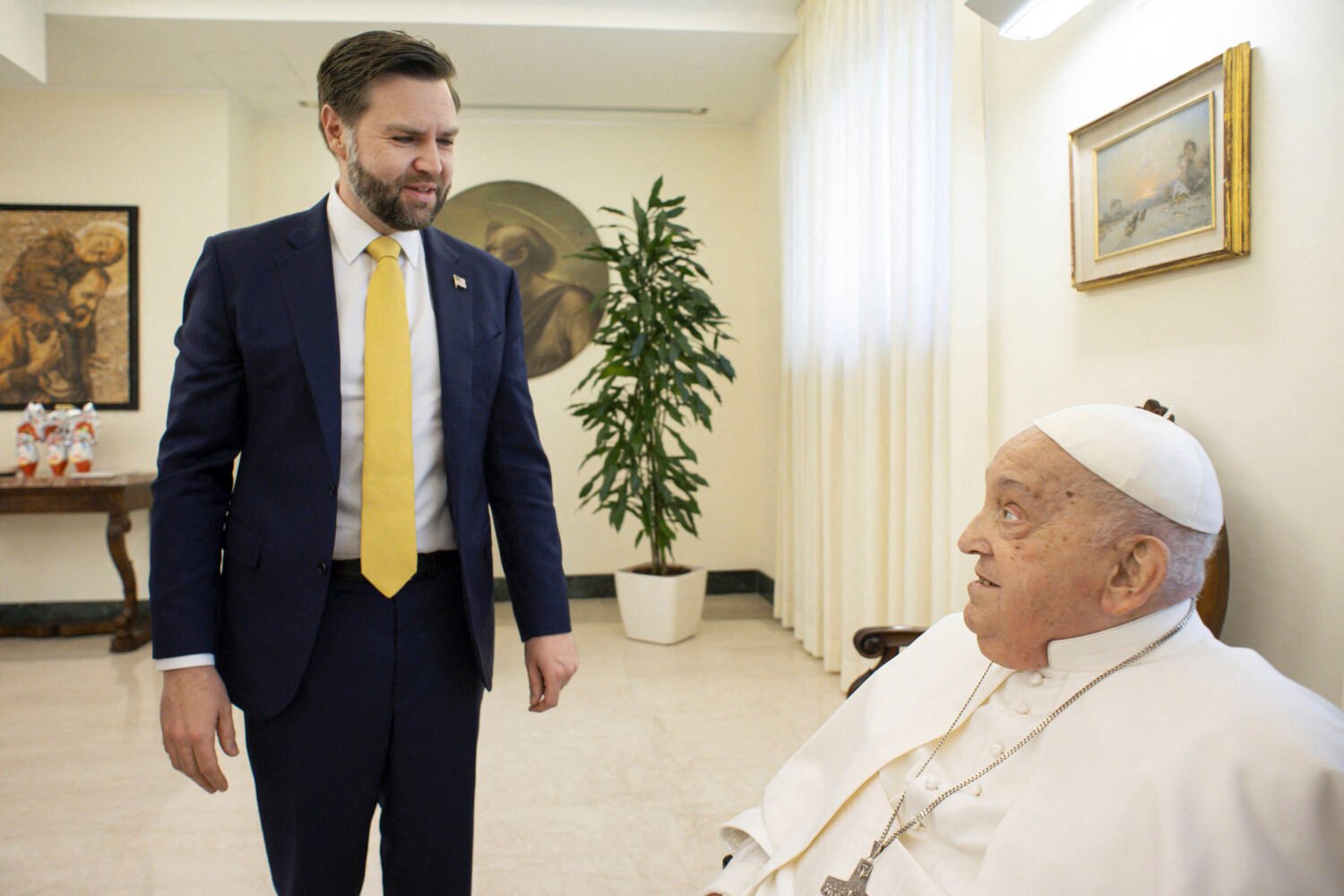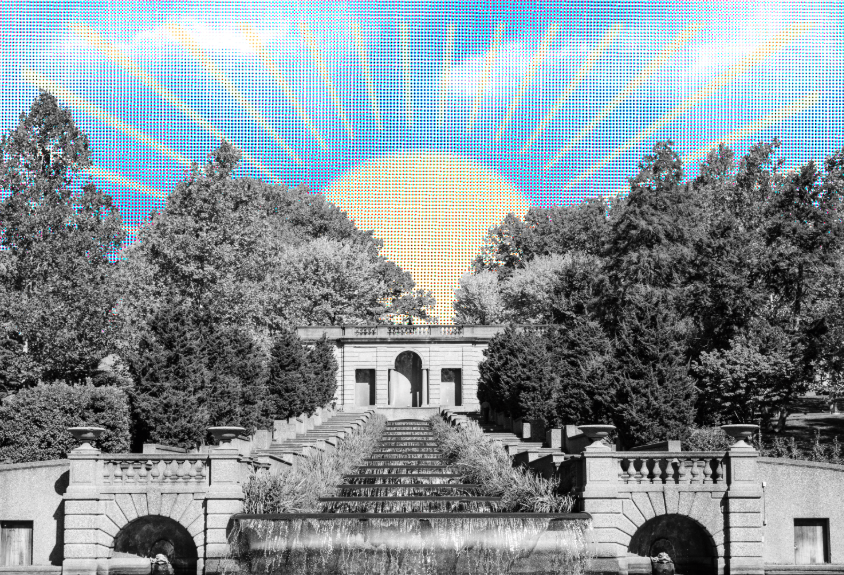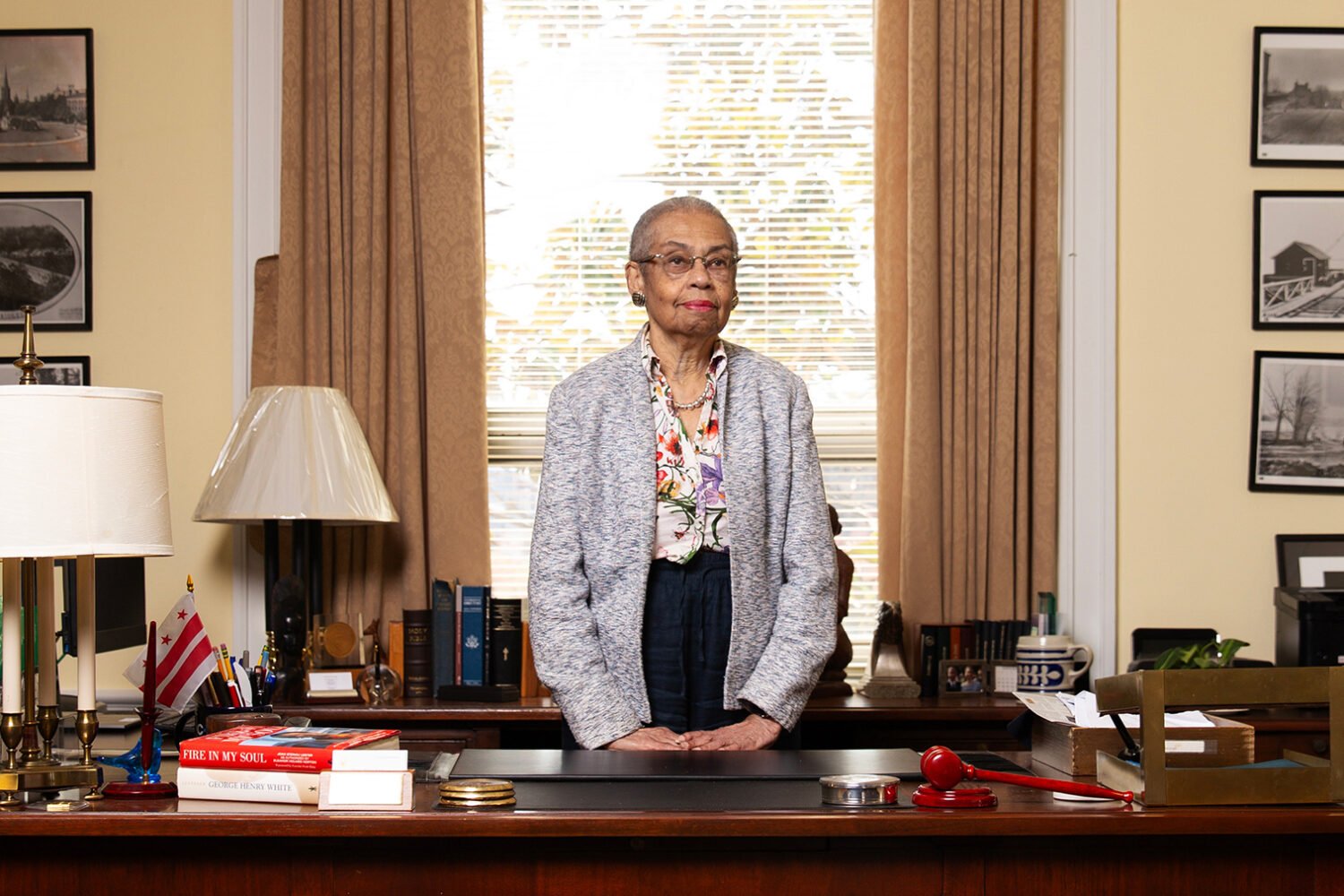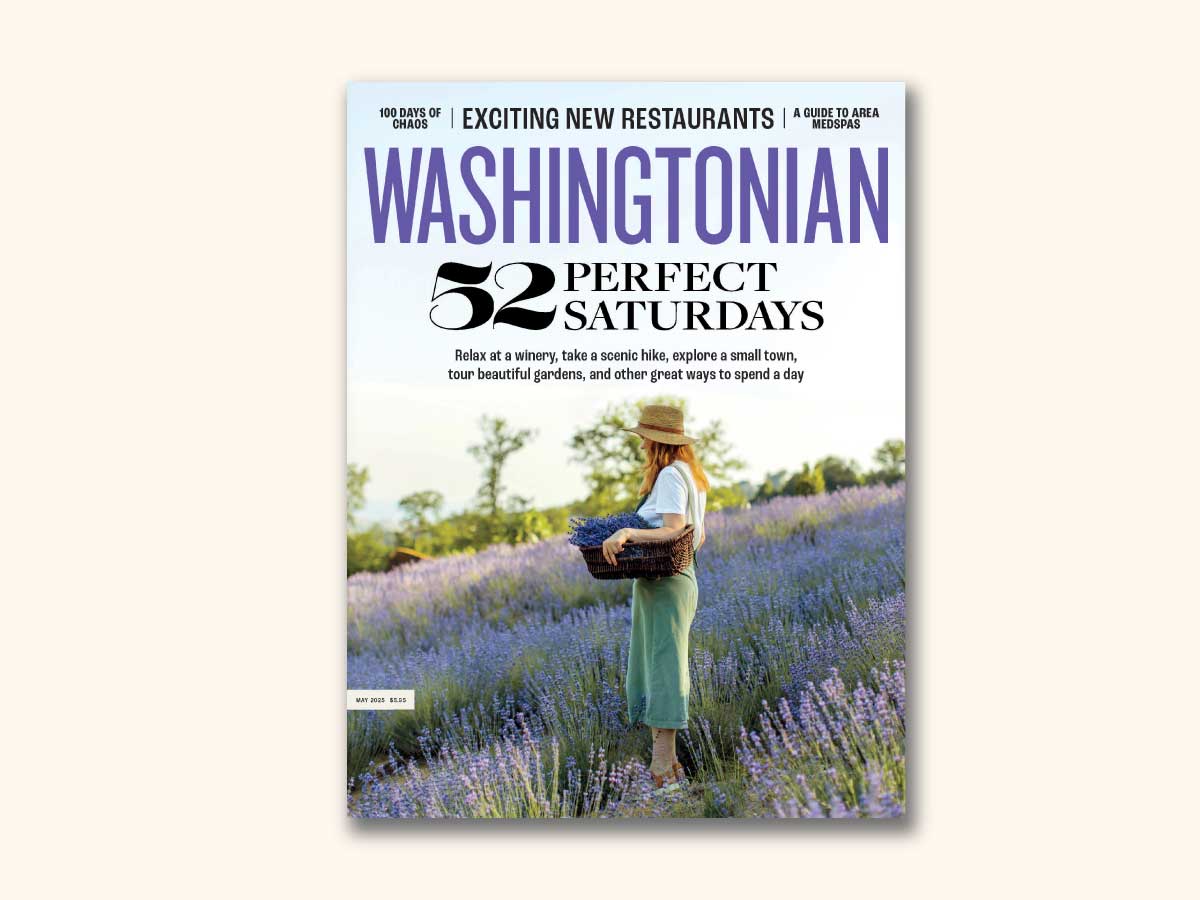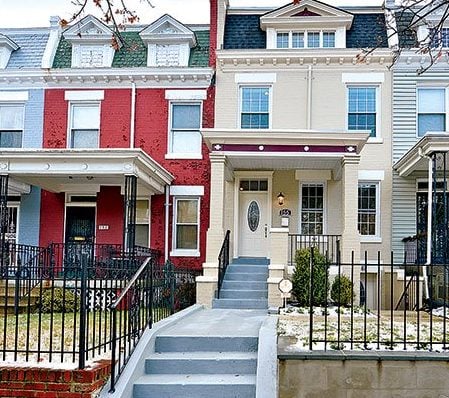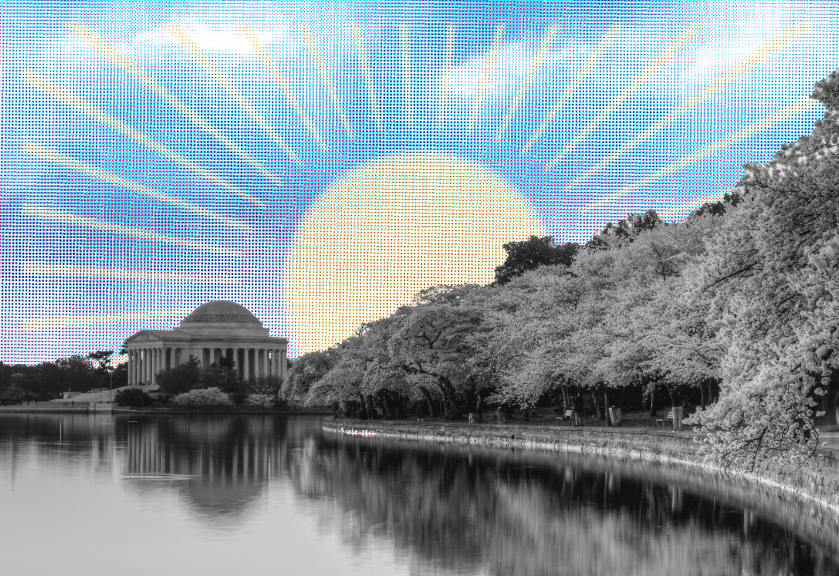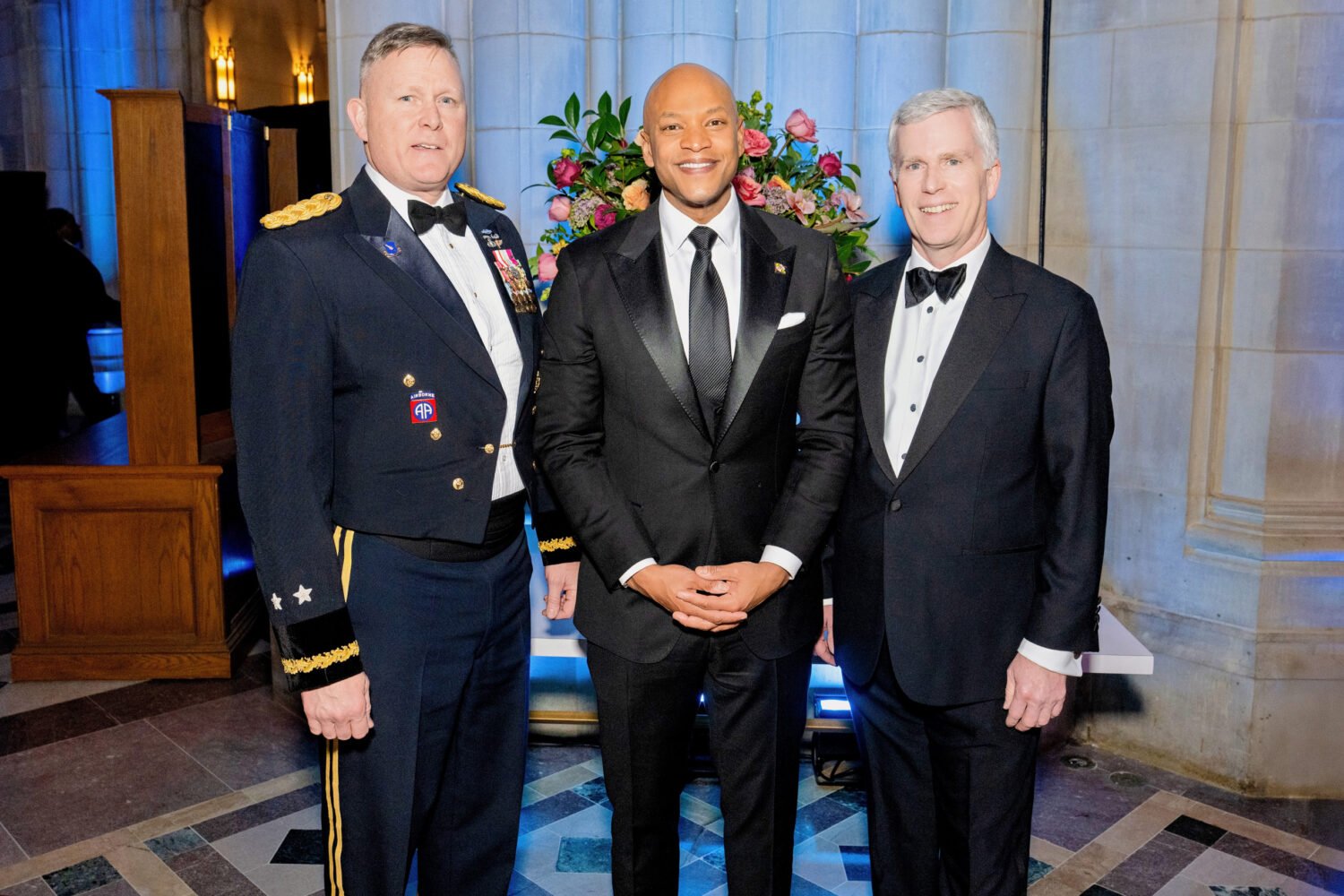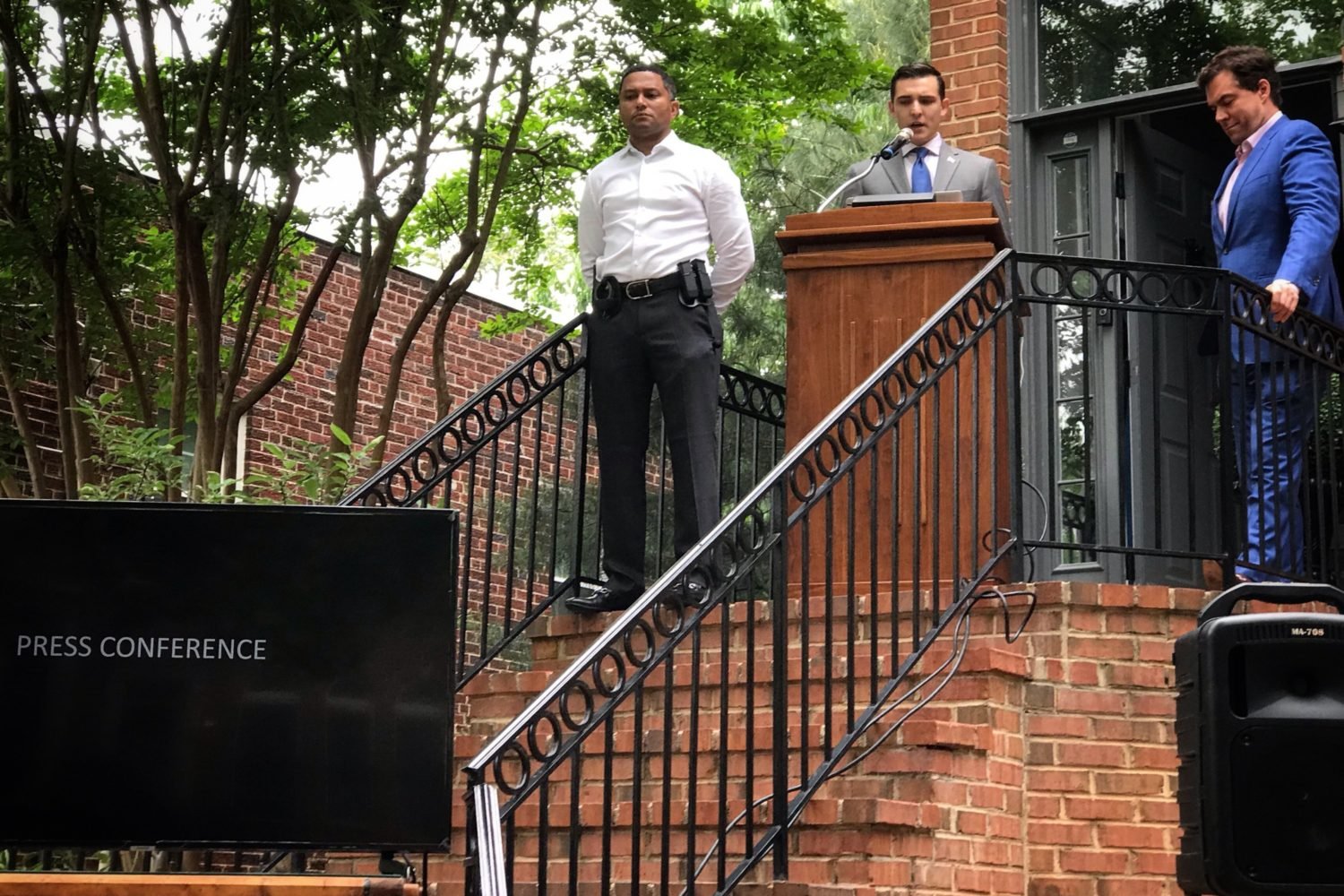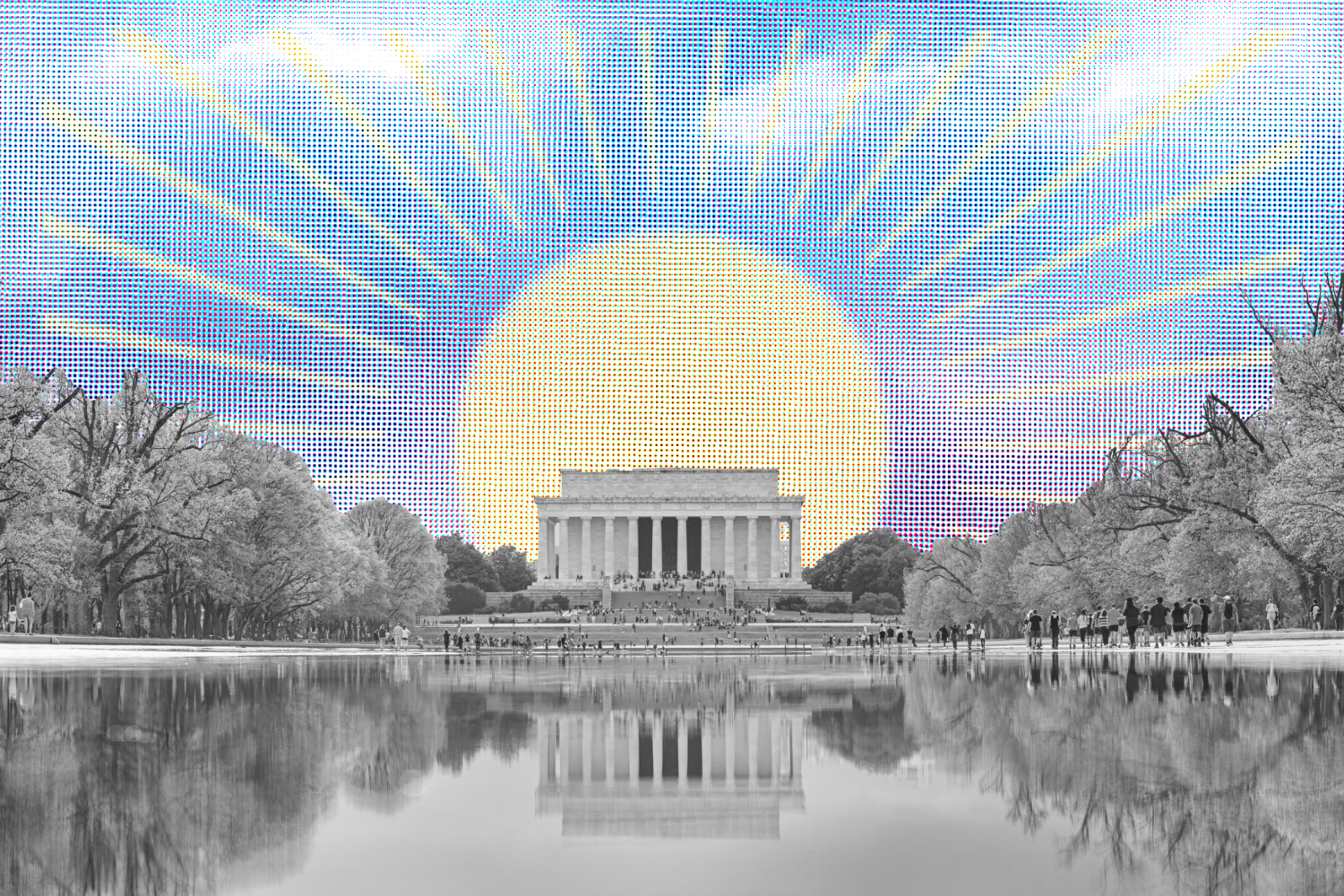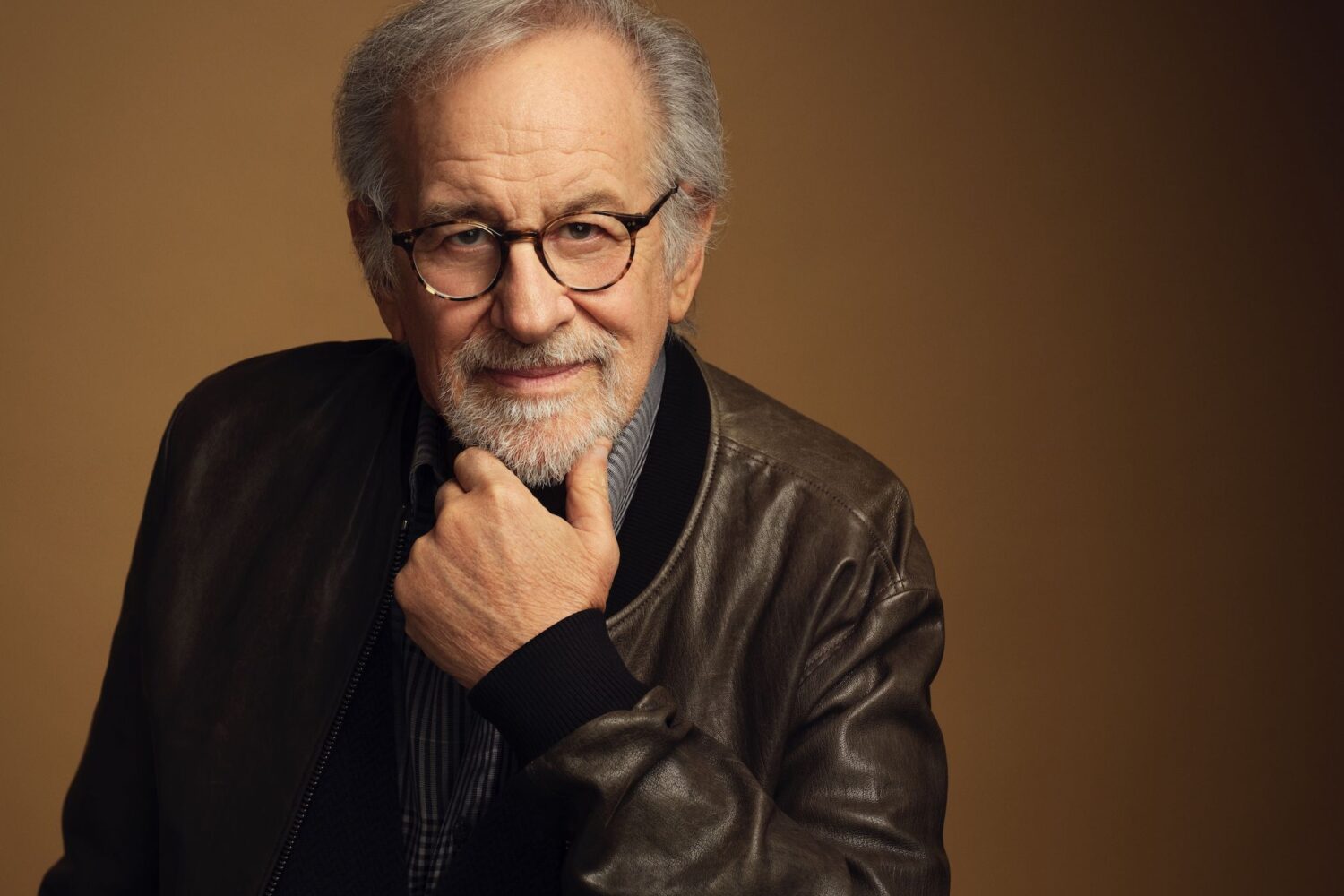Turkey owned a mansion on Embassy Row that served as the residence of its ambassador. It was a limestone palace on Sheridan Circle, originally built in 1915 for a Midwestern businessman who had invented the crimped bottle cap.
But Turkey’s chancery, which housed the offices of the country’s diplomatic mission, was less imposing—an old house farther up Massachusetts Avenue. For a nation of 70 million people, this old building was too small. There were not enough high-tech offices and little parking, and its classical-revival style suggested nothing of Turkish culture. The solution: Demolish it and build something much bigger.
After the idea surfaced in the 1980s, it aroused opposition from nearby homeowners in Kalorama, the fashionable neighborhood dotted with chanceries and ambassadorial residences. Historic preservationists also were committed to saving the old chancery, which was built in 1928 and had been declared untouchable by the DC Historic Preservation Review Board.
Turkey made some shrewd moves. After zoning officials rejected drawings for a new chancery, the country hired DC architect Shalom Baranes, known for designing buildings sensitive to their surroundings. Baranes came up with a new design that hid 30 percent of the building in four underground levels, reduced its footprint, and broke up its façade to make it less imposing. Turkey also retained Wayne Quin, one of the city’s canniest real-estate lawyers, and invited its neighbors in for cocktails to review the plans. Everybody agreed the Baranes design was better, but not even the stiffest of drinks could soothe the opposition.
The issue came to a climax one night in January 1991 in a hearing room of the Foreign Missions Board of Zoning Adjustment. Both sides were there in force—focused on this very local matter. It happened to be the night American aircraft began bombing targets to reverse Saddam Hussein’s takeover of the little oil-rich nation of Kuwait.
The beginning of the Persian Gulf War gave Turkey leverage against Kalorama residents and the preservationists. The Turks had cut off oil pipelines used by Hussein and provided a military staging area on Iraq’s northern border—a point Quin emphasized at the hearing. Also present were four high-ranking officials of the State Department. They made it clear that foreign-policy considerations trumped local objections.
The vote approving the project was unanimous. Turkey’s old chancery fell to the wrecking ball, and a new one stands there today. A double-towered edifice, with offices for the staff and rooms for entertaining, it has garnered praise from architecture critics. Out front flies the Turkish flag—red with a white crescent and star—and there’s a statue of Mustafa Kemal Atatürk, Turkey’s first president.
With dozens of chanceries and diplomatic residences, Washington is one of those places where international politics finds expression just down the street.
Driving around the city, you can get a sense of the pecking order of nations: Great powers occupy some of Washington’s grandest buildings, while many small nations settle for modest townhouses or rented offices.
Canada’s chancery sits on Pennsylvania Avenue with a view of the Capitol and unrivaled party space for inaugural parades and Fourth of July fireworks. But the chanceries of Liberia and Uganda are in converted houses up 16th Street beyond Carter Barron Amphitheatre.
The history of diplomatic outposts in Washington stretches across two centuries during which the world was carved into more and more independent states. Two world wars and the collapse of colonialism, the beginning and end of the Cold War, the rising importance of oil in the Middle East—all have reverberated through Washington neighborhoods. The breakups of the Soviet Union and Yugoslavia have added 20 new chanceries since 1991, along with a similar number of ambassadors’ residences.
Embassy Row speaks too of our adversaries.
Want to see more photos from Washington events and parties? Click here for Washingtonian.com's photo slideshow page.
At the blue-domed Iranian chancery on Massachusetts Avenue, once the scene of lavish parties fueled by the Shah’s oil wealth, Iranians have been absent since a rupture in diplomatic relations during the hostage crisis of 1979, and Iran’s coat of arms has been ripped from the front entrance. An Iranian Interests Section represents the country under the auspices of the Embassy of Pakistan.
A mansion on 16th Street near Meridian Hill Park, acquired by Cuba in 1916, still sits there nearly 50 years after Fidel Castro’s revolution with a brass plaque indicating that it is technically under the auspices of the Swiss but houses a Cuban Interests Section.
Several countries to which the United States once denied a diplomatic presence are back and open for business. With our war in Southeast Asia fading into history, relations with Communist Vietnam were established in 1995—and it has a chancery in a suite of offices near Dupont Circle and a residence on Sheridan Circle. Cambodia, no longer under control of the murderous Pol Pot, has a chancery and a residence on upper 16th Street. Muammar al-Qaddafi’s Libya, whose old embassy on Massachusetts Avenue has been sold, has full diplomatic status and an office in the Watergate. China, which has maintained offices in a converted hotel on Connecticut Avenue for the past three decades, is building a new chancery that will be one of Washington’s largest.
The war on terrorism has brought changes. Afghanistan, whose chancery in Kalorama Heights was closed after some of its diplomats sided with the Taliban, has reopened. Iraq’s chancery is in a renovated house on Massachusetts Avenue just below the Washington National Cathedral while its old chancery from Saddam Hussein’s day—a historic house near Dupont Circle—is being renovated.
A few countries have ended up in ironic juxtaposition. The Turkish ambassador, from his residence on Sheridan Circle, is within shouting distance of the Greek ambassador’s residence. Israel—the first country to build in the International Chancery Center, a tract of federal land set aside in Tenleytown for new chanceries—now shares the enclave with chanceries of the Arab states of Egypt, Jordan, Bahrain, and the United Arab Emirates.
It’s not always obvious from the street which country owns which property. Sometimes you can’t make out the name on the brass plaque. Many of the national flags—with their stars, moons, lions, and birds—aren’t familiar. And the architecture may be deceiving—the Algerian chancery is English Tudor; the Swedish ambassador lives in a Spanish-style hacienda once owned by U.S. News founder David Lawrence. The Brits have a statue out front of Winston Churchill with his cigar and V-for-victory gesture, and the Indians have one of Mahatma Gandhi, but most people probably pass cluelessly by the statues of patriotic figures from Bulgaria and Kazakhstan.
The chanceries and diplomatic residences often suggest exclusivity, as if reserved for VIPs enjoying fine wines in richly appointed rooms. Metal fences, even more common since 9/11, evoke a feeling that it’s best to move along before you catch the attention of the security officers.
Most countries maintain their largest foreign missions in Washington, and there is competition to stand out from the crowd. When Sweden opened its new chancery on the Georgetown waterfront in 2006, the king and queen came. When Monaco began sending its own diplomats abroad several months ago, Prince Albert II came to seal the deal for a historic Kalorama house to serve as the principality’s residence and chancery.
Most of the world’s 193 independent nations have full diplomatic representation in Washington; North Korea, Iran, and Cuba are the main exceptions. All typically have a chancery for office work and a separate residence for the ambassador—with the term “embassy” referring to both. In all, Washington has 297 chanceries or chancery annexes and 1,680 residential properties.
All of the chanceries and most ambassadors’ residences are in Northwest DC, not too far from the State Department and with prestigious addresses. Fourteen countries have residences for their ambassadors in Northern Virginia, especially in McLean, and 46 in suburban Maryland, mostly in Chevy Chase, Bethesda, and Potomac.
The embassies employ about 10,000 people—some with full diplomatic status and others, including local hires, in lower-level office jobs, including chefs and chauffeurs. A survey by the Greater Washington Board of Trade found 16 countries with at least 150 employees, led by Saudi Arabia, with 780, and followed by the United Kingdom, France, Russia, Brazil, Canada, Japan, Egypt, Australia, Germany, United Arab Emirates, Argentina, Spain, Indonesia, and Mexico. China, though not included in the survey, also has a large contingent.
Stephen Fuller, a professor at George Mason University, has estimated that embassies contribute $400 million a year to the local economy, though they are exempt from property taxes, as US embassies are abroad. And they add cultural variety to Washington. The list of ambassadors includes not just European names—Michael Collins (Ireland), Pierre Vimont (France), and Giovanni Castellaneta (Italy)—but Mahmud Ali Durrani (Pakistan), Sudjadnan Parnohadiningrat (Indonesia), and Faida Mitifu (Democratic Republic of the Congo).
The embassies have influence on the real-estate market. Competing to buy prized properties, they are a boon to sellers. Like everyone else, countries react to real estate’s old dictates of availability, location, timing, and price.
Though some countries have owned their properties for decades, there’s a lot of moving around. After Canada opened its new chancery on Pennsylvania Avenue, it sold its mansion on Massachusetts Avenue to Uzbekistan. Finland, after finishing a new chancery on Massachusetts Avenue, sold its old one on New Mexico Avenue to a consortium of five small Caribbean nations. When Australia built a new embassy on Scott Circle in 1969, it sold its old one to Peru.
A house at 3421 Massachusetts Avenue that is now the chancery of Iraq has been through many hands. Since 1960 it has housed diplomats from Sudan, Bangladesh, South Africa, Kazakhstan, and Côte d’Ivoire.
Many spectacular old mansions, which became white elephants during the Depression, might have been razed had they not been converted to chanceries and residences. Long before DC’s 1978 passage of tough historic-preservation laws, foreign nations were saving the city’s architectural legacy. Embassies also were pioneers in introducing Washington to modern architecture—a trend begun by Denmark, Switzerland, and Germany in the 1950s and ’60s and carried on recently by Brazil, France, Sweden, Canada, Finland, Italy, Switzerland, and Turkey.
Embassy events contribute to Washington’s social and cultural life. Dinners and receptions with exclusive guest lists still occur, often in the privacy of ambassadors’ residences. National days have long been moments of celebration—Bastille Day for the French, St. Patrick’s Day for the Irish, reunification day for the Germans. More embassies have begun opening their doors with public events featuring art and music. Last May, when two dozen European Union chanceries held open houses one Saturday, nearly 40,000 Washingtonians stood in line to get a peek.
Embassies can be magnets for protests on issues playing out thousands of miles away: freedom for Soviet Jews, an end to South African apartheid, independence for Eritrea, action on genocide in Sudan’s Darfur region, an end to China’s repression of the Falun Gong. Though Greenpeace long ago folded up the inflatable blue whale it used to protest the whaling practices of the Japanese, one man has been standing in front of the Vatican Embassy with a sign attacking pedophilia in the church for more than a decade.
Washington’s first Embassy Row was on 16th Street and was the creation of Mary Henderson, the real-estate-savvy spouse of a senator from Missouri. In 1888, the Hendersons built a brownstone on 16th Street, just beyond today’s Florida Avenue (then the northern limit of DC), and Mrs. Henderson set about buying land nearby on Meridian Hill for development. During the early 1900s, she built nearly a dozen lavish mansions that she sold or rented to foreign countries, including France and Italy, for use as chanceries or ambassadors’ residences.
The French and Italians have moved elsewhere, but several of these mansions remain in diplomatic service. Poland, Ecuador, Lithuania, and Cuba own properties there.
Sixteenth Street’s claim to the title of Embassy Row was short-lived, thanks to a real-estate boom around Dupont Circle and along Massachusetts Avenue. The British helped trigger it in 1872 by building Washington’s first foreign-owned legation just below Dupont Circle. The area attracted millionaires from around the country who had moved to Washington to elevate their social status and dabble in politics. All of them shared a desire for mansions built in Old World styles.
One of the most expensive homes, completed in 1903 at a cost of $835,000, stood on Massachusetts Avenue just above Dupont Circle and was built by Thomas Walsh, who had arrived in America as an Irish immigrant and made a fortune in gold mining. Designed in the Beaux Arts style, the four-story mansion had 50 rooms and featured a slab of gold ore over the entrance to remind Walsh of his good fortune. He became renowned for lavish parties, though he was not as famous as his eccentric daughter, Evalyn Walsh McLean, who once owned the Hope Diamond.
The Depression brought an end to the good times and left the grand houses at risk, as one millionaire after another departed. Some mansions were torn down, others were partitioned into apartments, and a few found other roles—as the Society of the Cincinnati, the Cosmos Club, and the Phillips Collection. But many were snapped up by foreign countries as chanceries and residences. The Walsh mansion—rented to a New Deal agency during the 1930s and donated as space for the American Red Cross during World War II—was sold to newly independent Indonesia in 1951 for $335,000.
Over the years, the old Millionaires Row was transformed into Embassy Row, stretching two miles along Massachusetts Avenue, from Scott Circle almost to Wisconsin Avenue. Several dozen of Washington’s most important chanceries and residences are located here.
Some countries occupy mansions from the early part of the 20th century—Portugal, India, Luxembourg, Ireland, Greece, Romania, Bolivia, South Africa, Norway, the Vatican. The chanceries of Japan and South Korea, which sit side by side on Massachusetts Avenue, were built at midcentury, while others—Turkey, Italy, Côte d’Ivoire, and Finland—are strikingly modern. Brazil has a 1910 Renaissance Revival mansion as its ambassador’s residence sitting beside a black-glass box built in 1971 as its chancery.
One of the biggest embassies on Massachusetts Avenue belongs to the United Kingdom. The ambassador’s residence, not visible from the street, was designed by British architect Sir Edwin Lutyens in the style of a Georgian country house. It was completed in 1931, and a modern chancery office building was added to the site in 1960. In the English garden, Queen Elizabeth entertained guests during her visit last year to commemorate the founding of Jamestown.
Kalorama has one of the biggest concentrations of chanceries and residences—its streets filled with polished black sedans bearing the flags of three dozen countries. The most striking residence is a French chateau that since 1936 has been the residence of the French ambassador, though it was built by an American mining magnate in 1910. It has a view from the back terrace of Rock Creek Park, which Charles DeGaulle once mistook for French property and said was appropriate for so great a nation as France.
Belgium’s ambassador occupies a chateau on Foxhall Road —a reproduction of a famous hotel in Paris— built in 1931 by a Nevada bank president who married two heiresses, one with money from Bromo-Seltzer and the other from Dodge automobiles. Italy’s envoy lives in a 59-room mansion adjoining Rock Creek Park in Forest Hills—assessed value $36 million—that was once owned by copper heir Robert Guggenheim. It’s called Villa Firenze—named by Guggenheim after his yacht. The Italians don’t seem to mind that Villa Firenze is built in the English Tudor style.
After the attack on Pearl Harbor in December 1941, diplomats in the Washington embassies of Japan, Germany, and Italy were told to pack their bags. At the German Embassy, then on Massachusetts Avenue just above Thomas Circle, smoke from burning documents rose from the chimney. The wife of the ambassador, after expressing regrets to a reporter that she’d have to leave behind her horse, wished everyone a Merry Christmas. Several dozen German Embassy personnel were relocated by train to the Blue Ridge Mountains, most to the Greenbrier resort in West Virginia and others to the Homestead, where they lived a life of luxury under house arrest.
They celebrated Christmas with a party that included caroling and an appearance by Kris Kringle, who passed out gifts to the children. In Germany, personnel from the American Embassy in Berlin, including George Kennan, were placed under guard at a resort in Bad Nauheim. It wasn’t until spring that both the Americans and the Germans were allowed to return home in an exchange handled by the Swiss.
As World War II rearranged the geopolitical order and turned the United States into a world power, it also strengthened Washington’s status as an international city. New York got the United Nations, but Washington got two new financial institutions, the World Bank and the International Monetary Fund, which today cover several square blocks west of the White House. They employ thousands of highly educated professionals from dozens of countries.
The war set off forces that created a new landscape of embassies here. Our wartime enemies—Germany, Japan, and Italy—regained diplomatic status and became bulwarks against Soviet Communism. But it was the creation of dozens of new nations that made it a busy time for Washington real-estate agents. At the outbreak of World War II just 50 nations had embassies in Washington—23 from Europe, 20 from Latin America, plus China, Japan, Thailand, Canada, South Africa, Egypt, and Turkey. By 1983, the number had grown to 133.
Many of the new nations emerged from the collapse of European colonialism. The Spanish and Portuguese had lost their empires in Latin America in the 19th century, and now the same fate befell the English, French, and others. Across Asia, Africa, the Caribbean, and the Middle East, the flags of the old powers came down and new ones went up.
Out of the old British Empire came India, Pakistan, and Nigeria. The French fought for their colonies but lost Vietnam, Cambodia, and Algeria, while the Dutch granted independence to Indonesia.
No embassy aroused so much curiosity in this period as the mansion owned by the Soviet Union on 16th Street north of the White House. The mansion had been built in 1910 by Hattie Pullman, widow of the founder of the Chicago sleeping-car company, as a home for her daughter and son-in-law, who had been elected to Congress. But he fell ill before moving in, and the mansion was sold in 1913 to Russia’s Czar Nicholas II, whose ambassador fled to Paris with the best paintings and furniture after the Bolshevik Revolution of 1917. The mansion stood empty until 1933, when Franklin Roosevelt granted diplomatic recognition to the Soviets. For the next several decades, especially during the long tenure of ambassador Anatoly Dobrynin, the mansion became known for vodka and caviar, secretive ways, and a rooftop collection of antennas.
The countries of Eastern Europe, though under Soviet domination, kept their embassies in Washington throughout the Cold War. Poland was in one of the old palaces on Meridian Hill, Romania was in a mansion on Sheridan Circle, Bulgaria had a house in Kalorama, the East Germans had a suite of offices in a building next to the Brookings Institution on Massachusetts Avenue, and Czechoslovakia and Hungary had chanceries in Forest Hills.
Lithuania, the little Baltic nation forcibly absorbed by the Soviets in 1940, was defiant. For 50 years, Lithuanian-Americans raised money to repair the country’s chancery on Meridian Hill and to keep it open as a symbol of anti-Soviet resistance. Now, with the Soviet Union collapsed, it is undergoing renovation and expansion.
The Cold War produced one of the strangest cloak-and-dagger episodes in the history of Washington’s embassies. In the 1970s, an agreement was negotiated allowing the United States to build a new embassy compound in Moscow and the Soviets to build a similar project in Washington. The Soviet site, known as Mount Alto, was on Wisconsin Avenue north of Georgetown and is today occupied by Russia.
This agreement led to tit-for-tat intrigue. We discovered that the KGB had embedded dozens of listening devices in our embassy in Moscow, which required sending American workers to rebuild a portion of the building. At the same time, the FBI and NSA dug a secret tunnel for electronic surveillance under the Soviet Embassy here, its entrance hidden by a nearby house. FBI agent Robert Hanssen is thought to have tipped off the Soviets to the tunnel’s existence.
China had maintained embassies in several District locations since the 19th century, but that changed with the triumph of Mao Zedong’s Communist revolution in 1949. The United States severed ties with mainland China, preferring to deal with the Chinese nationalists in control of Taiwan. The Communist mainland was not represented here until a trip there by Richard Nixon in 1972. After full relations were restored in 1979, the Chinese bought and renovated a hotel on Connecticut Avenue as their chancery, marked by stone lions protecting the entrance. At first the diplomats were a neighborhood curiosity in their Mao jackets, but those eventually were traded for business suits, and they developed a reputation for handing out lots of candy to children on Halloween.
Under the Shah, the oil-rich Iranians owned a big chancery whose blue dome and Persian decoration made it a landmark on Massachusetts Avenue. The country also owned a 46-room mansion next door—originally built for an heir to the Corning Glass fortune—where the Shah’s man in Washington, Ardeshir Zahedi, was famous for parties.
After the Shah was deposed by Islamic revolutionaries and Americans were taken hostage at our embassy in Tehran in 1979, normal diplomatic relations ended. All Iranian diplomatic properties here were seized, including the chancery and the ambassador’s residence. Over the years, the State Department has used the chancery for offices, including one that dispensed diplomatic license plates. The residence has twice served as the Decorators Show House to raise money for the National Symphony Orchestra and has been rented out to individuals.
Taiwan has the most convoluted representation in Washington. The United States does not recognize it as an independent country because doing so would threaten our relationship with mainland China, which claims the island of Taiwan. But ties are maintained through the Taipei Economic and Cultural Representative Office, which has offices in Washington and 12 other US cities. Taiwan owns a modern five-story building on Wisconsin Avenue in Tenleytown, with offices for staff members performing a full range of diplomatic functions, including issuing of visas and passports. It also owns, for entertaining, the Twin Oaks estate in Cleveland Park, whose grounds are larger than the White House compound. The estate’s mansion, reminiscent of a New England summer home, was built in 1888 and was once the home of Gardiner Greene Hubbard, first president of the National Geographic Society and father-in-law of Alexander Graham Bell.
Modern architecture arose in Europe in the 1920s, and the United States put the so-called International Style to use in the decades after World War II in its embassies abroad. The State Department commissioned some of America’s best-known modernists to design new embassies—Cesar Pelli in Tokyo, Marcel Breuer in the Hague, Eero Saarinen in London, Edward Durrell Stone in New Delhi, I.M. Pei in Montevideo, Harry Weese in Accra, and Walter Gropius in Athens. Jane Loeffler, a Washington-based scholar, makes the point: These embassies, whose glass façades were a metaphor for American freedom and openness, scored a Cold War public-relations win over the drab embassies of the Soviets.
Most architecture in Washington has been notably traditional—as late as 1965, half a century after the birth of modern architecture, the Rayburn House Office Building was completed in a neoclassical style suggesting imperial Rome. But in the 1950s and ’60s several European countries built new embassies that were among the city’s early examples of modernism. Many of these nations were able to commission their best designers from back home or countrymen who already had immigrated to America.
William Lescaze—born in Switzerland and the architect of Washington’s first modernist office building, at Connecticut Avenue and M Street, in 1940—designed a modern chancery for the Swiss in Woodley Park in 1959.
Another modern project, designed in 1953 but not finished until 1960, was built by Denmark. The small site—hidden away on Whitehaven Street and backing up to woods once a part of the Dumbarton Oaks estate—was turned over to Danish architect Vilhelm Lauritzen. He created an elongated glass-and-steel building in two parts—a chancery and a residence connected by a glass-enclosed bridge—that is filled with light and furniture showcasing Danish craftsmanship.
West Germany created a splash in 1963 with a new chancery on Reservoir Road that was designed partly to make a political point. The building, by German architect Egon Eiermann, had a stepped-back design that fit into a steep hill and a glass façade encased in an external grid of steel and wood. It was meant as a disavowal of the Nazi monuments that Albert Speer had conceived to please Adolf Hitler and as a reminder that modern architecture had its birth in Germany at the Bauhaus school.
Canada’s chancery on Pennsylvania Avenue, which opened in 1989, is unmatched in its visually prominent location—making Canada the only nation situated on the route of the presidential inauguration and with a clear view of the Capitol. The site was acquired as Washington was trying to revitalize Pennsylvania Avenue, and the embassy now seems an apt symbol of relations between next-door neighbors. It’s close enough to the Hill that senators have been known to interrupt a lunch at the embassy for a roll-call vote, then return for dessert. It’s also a good example of diplomatic reciprocity: The United States got a prestigious site for its new embassy near Parliament Hill in Ottawa.
Canada’s building, by Vancouver architect Arthur Erickson, is outfitted for public outreach with a theater, television studio, art gallery, exhibition hall, and rooftop party space. The façade features a large entrance courtyard with a rotunda supported by 12 round pillars, each representing one of Canada’s provinces or territories. The pillars and the sharp angle of one corner of the courtyard give nods to the Federal Trade Commission building and I.M. Pei’s National Galley of Art East Building, both across the street. Any sound under the rotunda creates a strong echo, and it has become a favorite spot for Canadian tourists to stand and belt out “O Canada.”
Finland, with a population not much bigger than metropolitan Washington’s, created buzz with the design of its new chancery. On Massachusetts Avenue near the vice president’s house and opened in 1994, the embassy was designed by Finnish architects Mikko Heikkinen and Markku Komonen. The light-filled building is sheathed in glass and copper and makes clear the Finnish attraction to modernity, standing in contrast to the Renaissance-revival mansions next door owned by the Vatican and Norway. It’s a building that suggests Finnish reverence for nature, with a cantilevered catwalk in the back that projects into a wooded lot, use of greenish-gray marble and green patina on the copper, and a trellis across the entire front that is covered in vines. It also includes that ultimate expression of Finnish culture—a sauna used for entertaining.
Italy’s big chancery, which sits on the edge of Rock Creek Park and is visible from Massachusetts Avenue just north of Glover Bridge, was designed by the Italian architect Piero Sartogo. Completed in 2000, it is a work of contemporary architecture with strong historic references. Its exterior is intended to evoke aspects of a Tuscan villa and an Italian Renaissance palace. The atrium provides space to showcase Italian design, from furniture to Ferraris, and leads to a cafeteria decorated with large images of Sophia Loren, Gina Lollobrigida, and Marcello Mastroianni.
Sweden’s new chancery on the Georgetown waterfront proves the importance of patience. For more than three decades ,Sweden operated out of office buildings, including the Watergate, as it sought a site for a new chancery. Its break came when Alan Novak, a commercial developer whose wife is Swedish, brought Sweden into a project that fills a long-vacant lot between Washington Harbour and Thompson’s Boathouse. The Swedish chancery faces the Potomac on the southern end of the lot. It’s dubbed the House of Sweden and has the distinction of being the only embassy ever built on the Potomac River.
The embassy has a sweeping view of the river with the Kennedy Center, Roosevelt Island, the Rosslyn skyline, and Key Bridge in the distance. The embassy has quickly become a landmark, especially at night, when it becomes a translucent glass box. Swedish architects Gert Wingarth and Tomas Hansen also included a bold cultural reference to their forested homeland—wide bands around a third-floor balcony that resemble an enlargement of the grain in a piece of wood. Another distinction: The top two floors are divided into office suites and apartments that will be leased to companies with Swedish connections. The model is furnished by Ikea.
Several notable ambassadors’ residences that are modern in style have been added to the landscape in the past decade. In 2006, the Swiss finished an avant-garde residence in Woodley Park by architects Justin Ruessli of Switzerland and Steven Holl of New York—a building that is environmentally friendly and whose charcoal-colored concrete and translucent glass were inspired by the black rocks and snow of the Swiss Alps. The new Spanish residence on Foxhall Road, completed in 2000, is by the country’s Pritzker Prize–winning architect José Rafael Moneo—a contemporary creation that suggests Moorish and Andalusian influences.
The most controversial new residence is that of the German ambassador atop a hill at the corner of Reservoir and Foxhall roads, completed in 1999 and designed by German architect O.M. Ungers. The building, with white marble pillars on its southern façade, is said by the architect to evoke George’s Washington Mount Vernon and Thomas Jefferson’s Monticello. It has been attacked in the German press as a revival of neo-Nazi classicism but has received many favorable reviews from American critics.
Finding suitable locations for new embassies—much like accommodating more memorials on the Mall—is a struggle. High-end neighborhoods don’t want any more chanceries, whose staffs take up lots of parking spaces. And the increasing desire for bigger facilities, with more offices and larger areas for public events, only exacerbates the space crunch.
One solution has been to encourage more chanceries to locate in neighborhoods distant from the traditional Embassy Row. The Saudi chancery is in a former insurance-company office building next to the Watergate and the Kennedy Center. The chanceries of Mexico and Spain are in office buildings on Pennsylvania Avenue west of the White House. And a few countries—Sweden, Thailand, Venezuela, and Ukraine—have chanceries in Georgetown.
The biggest effort to create new sites for embassies is the International Chancery Center, a 47-acre tract straddling Van Ness Street between Reno Road and Connecticut Avenue. The land, near the University of the District of Columbia, was occupied by the National Bureau of Standards, which moved to Gaithersburg in the 1960s. In 1968, Congress set aside this surplus federal land to be leased at subsidized rates to countries wishing to build new chanceries, creating a suburban-style office park, complete with curved street and cul-de-sacs.
Part of the site is occupied by Intelsat, the international satellite company, whose striking building is a landmark on Connecticut Avenue. Less visible, up the hill, are modern chanceries built over the past 20 years by 17 nations. Israel leased the first space, and Morocco will get the last; the full list includes nations from Europe (Austria, Slovakia), Africa (Nigeria, Ethiopia, Ghana), the Middle East (Egypt, Jordan, Bahrain, United Arab Emirates), and Asia (Pakistan, Bangladesh, Malaysia, Singapore, Brunei).
The biggest chancery, occupying three lots fronting on Van Ness Street, will belong to China. Its 300,000 square feet will make it one of the largest embassies built in Washington—a symbol of China’s status as the world’s most populous nation and a fast-emerging economic power. It took a dozen years of negotiation by the State Department to arrange the deal with China, which allows the United States a reciprocal site for a new embassy in Beijing.
The design of the embassy here—by the firm of I.M. Pei, with input from the retired Chinese-American architect— will feature east and west office wings with an entrance pavilion between them and will be accented by Chinese ornamental gardens. The construction, to be finished later this year, is being done by hundreds of workers imported from China who live in a fenced-off Days Inn on New York Avenue leased by the Chinese government.
All embassies are protected by the Uniformed Division of the Secret Service and most have additional security arrangements of their own, but none has a reputation for thoroughness quite like that of Israel. Its chancery is protected by cameras, motion and sound sensors, a steel fence, a locked gate, a guardhouse, a brick wall, and a heavy steel cable to repel truck bombs. Construction will begin soon inside the compound on a small private residence for the ambassador. He now lives in Forest Hills, but this will allow him to be better protected at all hours.
With all the lots in the International Chancery Center committed, attention is turning to other locations for future embassies. Though the State Department has signaled that it might accept chanceries in the suburbs, the National Capital Planning Commission is opposed. In a plan issued in 2001, it suggested half a dozen DC locations. Some are areas that need revitalization—portions of 16th Street in Columbia Heights, Mount Pleasant, and Adams Morgan as well as the Anacostia waterfront and the South Capitol Street corridor. Other possibilities include land that may become available as it is vacated by Walter Reed Army Medical Center and DC General Hospital.
A lot of the work that goes on in chanceries is routine. Some employees are in consular affairs, dealing with passports and visas; others maintain contact with the State Department, Congress, and the US military; and others encourage investment and tourism. Some staff members, like those in the chancery of El Salvador on 16th Street, are dealing with a large Washington-area community of immigrants. Trade promotion is an important function—whether involving bottled water from Fiji, lamb from New Zealand, Marimekko from Finland, or hydrogen-powered BMWs from Germany.
But any architect setting out to design a new chancery must deliver plenty of space for events intended to showcase a country’s culture. “Public diplomacy” is the catchword, and Washington’s embassies open their doors each year to art exhibitions, craft shows, lectures, symposia, concerts, plays, fashion shows, programs for children, films, dances, winetastings, and ethnic buffets.
You can tango with the Argentineans, sip rum with the Cubans, listen to opera with the Italians, hear panelists discuss Sigmund Freud with the Austrians, or have a drink with the Germans, whose ambassador’s residence has the Berlin Bar, a cocktail lounge with a neon sign, in its lower level. France’s embassy on Reservoir Road was built in 1983 with a special wing—La Maison Française—devoted to celebrating all things French, and several countries have freestanding cultural institutes. The independently run Embassy Series has sponsored concerts in about 40 embassies over the past dozen years.
Embassies also are pillars of Washington’s charity circuit, donating space for fundraising parties, which rewards countries with networking opportunities among an affluent crowd. For 55 years, Goodwill raised millions of dollars with a spring embassy tour, but it has not been held since 9/11 due to security concerns, and the Washington National Opera uses the most lavish ambassadors’ residences for many of its galas.
Since countries began building from scratch rather than renovating old townhouses and mansions, they’ve had to confront the question of whether—and how—to express their culture in design. Kuwait built a combined chancery and residence on Tilden Street in the 1960s with many traditional Arab features. When South Korea built a new residence in Spring Valley in the 1980s, it featured rice-paper screens, lanterns, and other traditional elements.
A few countries use statues and other symbols as cultural markers. Churchill flashing his cigar and a V for victory outside the Embassy of the United Kingdom is the best known, but there’s also a statue of Crown Princess Märtha in front of the Norwegian residence and a coat of arms with a kangaroo and emu in front of the chancery of Australia. Japan has a golden chrysanthemum over the entrance to its chancery, and the Saudi chancery is decorated with multiple images of its seal, which features a palm tree and crossed swords.
The walls of the Mexican Cultural Institute are covered with Diego Rivera–style murals, the United Kingdom’s residence has featured fabrics by Laura Ashley and soaps by Crabtree & Evelyn, the Vatican chancery has stained glass illustrating The Divine Comedy, and Japan’s big modern residence on Nebraska Avenue—assessed value $37 million—features a traditional teahouse, garden, and koi pond. Finland first planted vines on its trellis that would flower in blue and white like the Finnish flag. But they did not thrive, and the embassy had to settle for vines with a white blossom only.
The buildings speak in many languages, expressing themselves in ways devised by architects who looked into each country’s traditions for clues. The roof of Malaysia’s entrance is covered in traditional red tiles, the United Arab Emirates façade has Arabic motifs (and inside there are palm trees and a nomad’s tent), Ghana’s exterior is adorned with large African adinkra symbols, and Egypt’s entrance suggests a pharaoh’s tomb. Nigeria’s chancery, another Shalom Baranes building considered by many critics the International Chancery Center’s best, is a nice piece of classic modernism, but it also features a skylit courtyard arranged centrally in the manner of a Nigerian village.
Hardly any of these nations had embassies here at the end of World War II because they had yet to achieve independence. But back then Washington itself was smaller and more insular. No World Bank employees lunched in the parks along Pennsylvania Avenue, and no nonstop flights flew out of an international airport to Europe, Asia, South America, or the Middle East. There were no Vietnamese, Ethiopian, or Thai restaurants, no immigrant construction workers wired money home to El Salvador, and rare was the taxi driver who stopped, pulled out a prayer rug, and turned east toward Mecca to pray.

